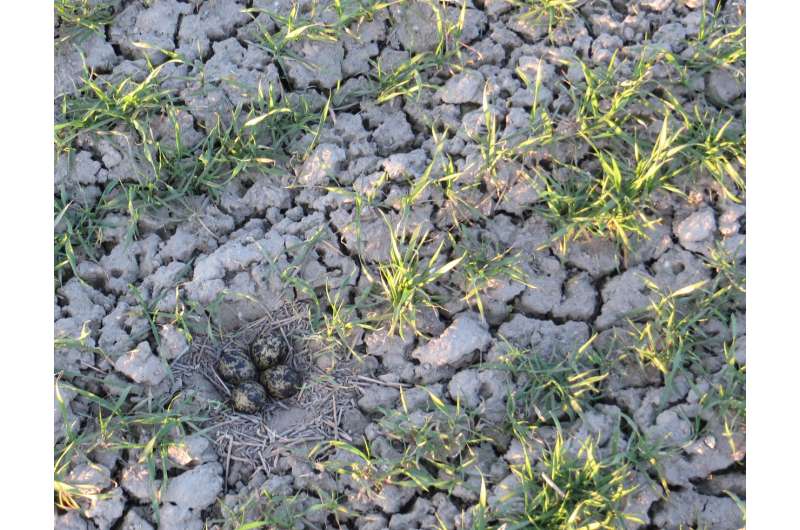Lapwing nest Andrea Santangeli. Credit: University of Helsinki
A new study shows that birds have shifted the time of their breeding much more quickly than Finnish farmers are anticipating their sowing times. This means that more birds are laying their eggs on fields that are still to be sown, a mismatch in timing that is most likely fatal for the bird nests.
"As the eggs of curlew and lapwings are placed on unsown fields, they are likely to be run over by farming machinery during sowing operations even if farmers were willing to avoid nest destructions," says researcher Andrea Santangeli from Finnish Museum of Natural History, part of the University of Helsinki.
Modern agriculture is catastrophic for farmland wildlife
The rush to produce more food to feed an ever-increasing society has led to unprecedented transformations in farmland over the past 50 years. The challenge of increasing crop yields was met by making extensive use of chemicals, like pesticides and herbicides to remove pests and weeds, and by making fields larger and homogeneous.
At the same time, agricultural practices have been mechanized, so that machines allow managing large areas efficiently. These changes, while increasing food production, have been catastrophic for the diversity of wildlife species living in farmland, including birds. Bird species, such as the lapwing and the curlew that lay their eggs on the ground of arable fields have paid the highest costs of the recent changes in farming practices.
Mechanical sowing of large arable areas in spring causes the destruction of many lapwing and curlew nests and traditionally, the majority of the birds started breeding later and thus avoided nest destruction. The new study found that this issue has grown much bigger under climate change. The long-term ringing data of breeding curlew and lapwings since 1970s suggest that as a result of shifts in timing of breeding, the incoming mechanical sowing destroys most of the nests that are laid on arable land.
Understudied area
The whole field of linking responses of humans and wildlife to climate change has been so far largely understudied. The study is among the first ones to investigate changes in the timing of land management in relation to changes in the timing of key life-stages of wildlife, but the observed pattern is unlikely unique.
"We believe the types of outcomes uncovered in the Finnish context may be common also in other systems," says Santangeli.
As the authors uncovered a potentially very important conservation issue for the target group of species, they also recommended solutions in the paper to be published in Biological Conservation. As part of the solution, the authors suggest the wider promotion of effective schemes, such as the Agri-environment schemes, that are part of the European Union strategy for helping biodiversity in farmland.
More information: Andrea Santangeli et al. Stronger response of farmland birds than farmers to climate change leads to the emergence of an ecological trap, Biological Conservation (2017). DOI: 10.1016/j.biocon.2017.11.002
Journal information: Biological Conservation
Provided by University of Helsinki























